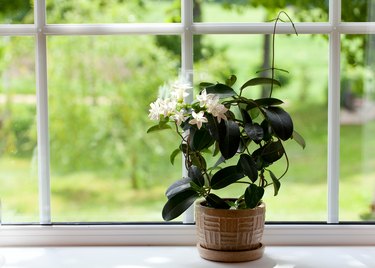
The fragrance of jasmine (Jasminum, USDA plant hardiness zones 7 to 10) can seem almost intoxicating. Thought to be rich, sweet and sensual, many consider it to be an aphrodisiac. Growing these white-flowered plants is not difficult, but when jasmine leaves are drying, it could be a sure sign of trouble. There are a few reasons you might see your jasmine plant drying up, and proper care can make it healthy again.
Jasmine Plant Drying Up
Video of the Day
If your jasmine plant is drying up, it could be all about the watering. Jasmine leaves drying can occur from either not enough or too much water. The soil should be moist but never soggy; otherwise, the roots will get damaged and be unable to absorb water. The top 30 percent of the soil needs to dry out before watering; never let jasmine plants sit in standing water.
Video of the Day
Conversely, when jasmine plants get too little water, their roots will not be able to capture the nutrients from the soil. This stops those nutrients from traveling up to the leaves, and they can then dry up and fall off the plant. It is a good idea to maintain a regular watering schedule and to frequently check how wet or dry the soil feels.
If your jasmine is in a pot, water it enough to allow water to drain from the bottom drip holes. During the hotter months, you can water outdoor jasmine more than once a week but still let the soil dry out between waterings.
Sunlight, Soil and Fertilizer
Proper sunning and soil will also prevent jasmine plants from drying up, and these conditions being correct will also help them to thrive. They do best in full sun to light shade, so keep them out of dark areas. Keep the plants in well-drained soil that is more sandy and without clay.
You can fertilize them regularly with a high-nitrogen feeder to help them grow faster or try a standard balanced fertilizer or one that is high in phosphorous to encourage flower growth.
Jasmine Plant Care and Propagation
It is also important to keep in mind that some varieties of jasmine do well outdoors, while others are more suited to be houseplants. If you do not know what variety of jasmine you have, find out and do some research.
Some jasmine varieties require more aggressive pruning in warm weather. Some grow on vines and may need to be trained to grow on trellises. You can pinch off the excess vines and keep them nicely trimmed. The goal is to keep the jasmine at the desired size, whether it is a vine or a shrub.
To propagate jasmine successfully, it is best to take cuttings and trim them down to 4 to 6 inches long. You can then apply some rooting growth hormone to the cut end and put it right into a container that is filled with damp sand. Then, cover them with a plastic bag to help retain moisture. Keep the planted cuttings in an area where the temperature is at least 75 degrees Fahrenheit (they are tropical plants) and out of direct sunlight. After the seedlings sprout, be sure to plant them outside only when the weather is at least 70 degrees.